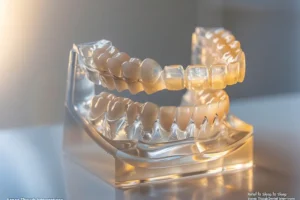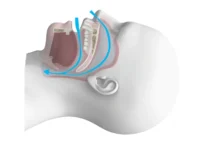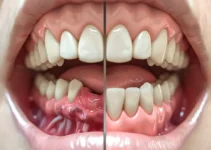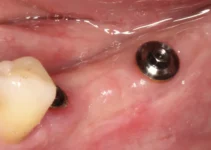Many individuals struggle with sleep apnea, a condition that interrupts normal breathing patterns during sleep. While CPAP machines are commonly prescribed for this condition, dental interventions offer an alternative form of relief. Specially designed oral appliances can help by adjusting the position of the jaw and tongue, thus improving airway openness. These devices are not only effective but also less invasive and can provide significant relief for those suffering from sleep apnea.
Understanding Sleep Apnea
Sleep apnea is a potentially serious sleep disorder characterized by repeated interruptions in breathing during sleep. These interruptions, or apneas, can last for several seconds and may occur numerous times throughout the night. Understanding sleep apnea is crucial for recognizing its symptoms, identifying risk factors, and seeking appropriate treatment.
Sleep apnea affects millions of people worldwide, and it can significantly impact overall health and quality of life. This article aims to provide a comprehensive overview of sleep apnea, from its definition to common symptoms and risk factors.
What is Sleep Apnea?
Sleep apnea is a condition where breathing temporarily stops during sleep due to partial or complete blockage of the upper airway. There are three main types of sleep apnea: obstructive sleep apnea (OSA), central sleep apnea (CSA), and complex sleep apnea syndrome (also known as treatment-emergent central sleep apnea).
Obstructive Sleep Apnea (OSA) is the most common type and occurs when the muscles at the back of the throat relax excessively. Central Sleep Apnea (CSA) is less common and results from a failure of the brain to send appropriate signals to the muscles involved in breathing. Complex sleep apnea syndrome is a combination of both OSA and CSA.
Research indicates that untreated sleep apnea is linked to various health issues, including high blood pressure, heart disease, stroke, diabetes, and depression. It’s essential to diagnose and manage sleep apnea to prevent these potential complications.
Common Symptoms of Sleep Apnea
Recognizing the common symptoms of sleep apnea is essential for early diagnosis and treatment. Some of the most frequent symptoms include:
- Loud, disruptive snoring
- Episodes of breathing cessation observed by another person
- Gasping for air during sleep
- Waking up with a dry mouth or sore throat
- Morning headaches
- Excessive daytime sleepiness (hypersomnia)
- Difficulty concentrating
- Irritability or mood changes
If you or someone you know exhibits these symptoms, it’s advised to consult a healthcare professional. A sleep study may be necessary to confirm the diagnosis of sleep apnea.
Risk Factors and Causes
Several risk factors and underlying causes can increase the likelihood of developing sleep apnea. These factors can be broadly categorized into physical traits and lifestyle choices:
- Excess Weight: Obesity significantly increases the risk of obstructive sleep apnea due to fat deposits around the upper airway.
- Neck Circumference: A thicker neck can narrow the airway, leading to breathing problems during sleep.
- Age and Gender: Sleep apnea is more common in older adults and males.
- Family History: Genetic predisposition can play a role in developing sleep apnea.
- Use of Alcohol or Sedatives: These substances relax the muscles in the throat, exacerbating sleep apnea.
- Smoking: Smoking increases inflammation and fluid retention in the upper airway.
Other causes include nasal congestion, medical conditions such as heart disorders, and anatomical abnormalities like enlarged tonsils or a deviated septum. Understanding these risk factors is essential for preventive measures and effective management of sleep apnea.
For readers interested in further exploring this topic, we highly recommend delving into our other articles about treatment options, lifestyle modifications, and the connection between sleep apnea and overall health.
Dental Interventions for Sleep Apnea
Sleep apnea is a serious sleep disorder characterized by repeated interruptions in breathing during sleep. These interruptions can lead to a variety of health issues, including cardiovascular problems and daytime fatigue. Dental interventions can be an effective treatment option for certain types of sleep apnea, particularly obstructive sleep apnea (OSA). By using specialized dental devices, patients can maintain an open airway during sleep, thereby reducing or eliminating breathing interruptions.
The effectiveness of dental interventions in treating sleep apnea has been supported by numerous studies. According to the American Academy of Dental Sleep Medicine, oral appliances are a proven treatment for mild to moderate OSA and can be a viable alternative for patients who cannot tolerate Continuous Positive Airway Pressure (CPAP) therapy. Dental devices work by repositioning the jaw and tongue to keep the airway open, improving sleep quality and overall health.
However, not all dental devices are created equal, and selecting the right one depends on the patient’s specific condition and needs. Consulting with a dentist specializing in sleep apnea is crucial for determining the most suitable device and ensuring proper fit and function.
How Dental Devices Work
Dental devices for sleep apnea primarily function by repositioning the lower jaw (mandible) and tongue to prevent airway obstruction during sleep. These devices are custom-made to fit the patient’s mouth and are usually worn at night. By moving the jaw forward, these appliances help to keep the airway open, reducing the likelihood of apneic events.
There are various mechanisms through which dental devices can achieve this. Some devices work by advancing the mandible (mandibular advancement devices), while others hold the tongue in place to prevent it from collapsing backward (tongue-retaining devices). The specific type of device used will depend on the patient’s anatomy and the severity of their sleep apnea.
Research has shown that dental devices can be highly effective for patients with mild to moderate OSA. According to a study published in the Journal of Clinical Sleep Medicine, oral appliances have been shown to significantly reduce the Apnea-Hypopnea Index (AHI), a measure of sleep apnea severity. This reduction in AHI not only improves sleep quality but also reduces the risk of associated health complications.
Types of Dental Devices
There are several types of dental devices available for the treatment of sleep apnea. These devices can be broadly classified into two categories: mandibular advancement devices (MADs) and tongue-retaining devices (TRDs). Each type has its own advantages and suitability depending on the patient’s condition.
Mandibular advancement devices (MADs) are the most commonly used dental appliances for sleep apnea. These devices work by repositioning the lower jaw forward, which helps to keep the airway open. MADs are custom-made to fit the patient’s mouth and are adjustable to ensure comfort and effectiveness. They are particularly effective for patients with mild to moderate OSA.
Tongue-retaining devices (TRDs), on the other hand, hold the tongue in a forward position to prevent it from collapsing backward and obstructing the airway. These devices are less commonly used than MADs but can be effective for patients who cannot tolerate mandibular advancement or for those with specific anatomical considerations.
In addition to these two main categories, there are also combination devices that incorporate features of both MADs and TRDs. These devices offer a greater degree of customization and versatility, making them suitable for a wider range of patients. Regardless of the type of device used, proper fitting and regular follow-up are essential for achieving optimal results.
For more detailed information on other dental interventions and their effectiveness, be sure to check out our other articles.
Benefits and Considerations
When considering dental interventions, particularly implants and bone regeneration, it’s essential to understand the potential benefits and considerations involved. These procedures can significantly improve oral health, functionality, and aesthetics but come with their own set of risks and requirements. In this section, we will dive into the various advantages these procedures offer, the potential side effects, and the importance of consulting with a qualified dentist to ensure the best outcomes.
Advantages of Dental Interventions
Dental interventions such as implants and bone regeneration offer several significant advantages. One of the primary benefits is the restoration of functionality. For instance, dental implants can mimic the function and appearance of natural teeth, allowing patients to chew, speak, and smile without discomfort or embarrassment. Another benefit is the prevention of further bone loss. Dental implants help to stimulate the jawbone, preventing the bone deterioration that often follows tooth loss. Additionally, these interventions can enhance aesthetics, contributing to a more youthful appearance and boosting self-confidence.
Other benefits include:
- Long-term durability and reliability.
- Improved oral health and hygiene.
- Enhanced comfort compared to removable dentures.
Overall, dental interventions can lead to a dramatic improvement in quality of life for many patients.
Potential Side Effects
While the benefits of dental interventions are numerous, it’s crucial to be aware of the potential side effects. One common issue is the risk of infection, which can occur if the surgical sites are not properly cared for. In rare cases, implants might not integrate with the bone properly, leading to failure.
Some patients may experience side effects such as:
- Swelling and bruising of the gums and face.
- Pain at the implant site.
- Minor bleeding.
These side effects are generally temporary and manageable with proper post-operative care and medication.
It should also be noted that individuals with certain medical conditions or habits (such as uncontrolled diabetes or smoking) may face increased risks and complications. Always discuss these factors with your dentist to ensure that dental interventions are appropriate for your situation.
Consulting with Your Dentist
Consulting with your dentist is a crucial step before undergoing any dental intervention. A thorough consultation ensures that you understand the procedure, its benefits, and any potential risks. Your dentist will evaluate your oral health, medical history, and specific needs to develop a customized treatment plan.
During the consultation, it’s important to ask questions and express any concerns you may have. A good dentist will provide detailed explanations and help you make an informed decision. They may also use diagnostic tools such as X-rays or 3D imaging to assess the condition of your jawbone and overall oral health.
Additionally, your dentist will provide pre-operative and post-operative instructions to help you prepare for the procedure and ensure a smooth recovery. Following these guidelines closely can significantly enhance the success of your dental intervention.
By taking the time to consult with a qualified professional, you can make informed decisions that lead to better outcomes and long-term oral health. For more information on dental health and treatments, be sure to explore our other articles.
Exploring Dental Solutions for Sleep Apnea Relief
Discover how dental interventions can provide relief for individuals suffering from sleep apnea. Here are some frequently asked questions about the role of dental strategies in managing this condition.
How can dental appliances help relieve sleep apnea?
Dental appliances, like Mandibular Advancement Devices (MADs), work by gently pushing the lower jaw forward, which helps to open the airway during sleep. This can significantly reduce the frequency of breathing interruptions, known as apneas, making it a viable and non-invasive treatment option for many patients with obstructive sleep apnea.
Are there any side effects of using dental appliances for sleep apnea?
While dental appliances are effective for many, they may cause minor side effects such as jaw discomfort, excessive salivation, or changes in bite alignment over time. However, these issues can often be easily managed with the help of a skilled dentist specialized in sleep apnea treatments, ensuring both comfort and efficacy in the long term.

My name is Salman Kapa, a 73-year-old expert in bone regeneration and dental implantology. With decades of experience in the field, I am dedicated to advancing our understanding of oral health and hygiene. Through my research and writing, I aim to contribute to the development of innovative solutions in dental care.




